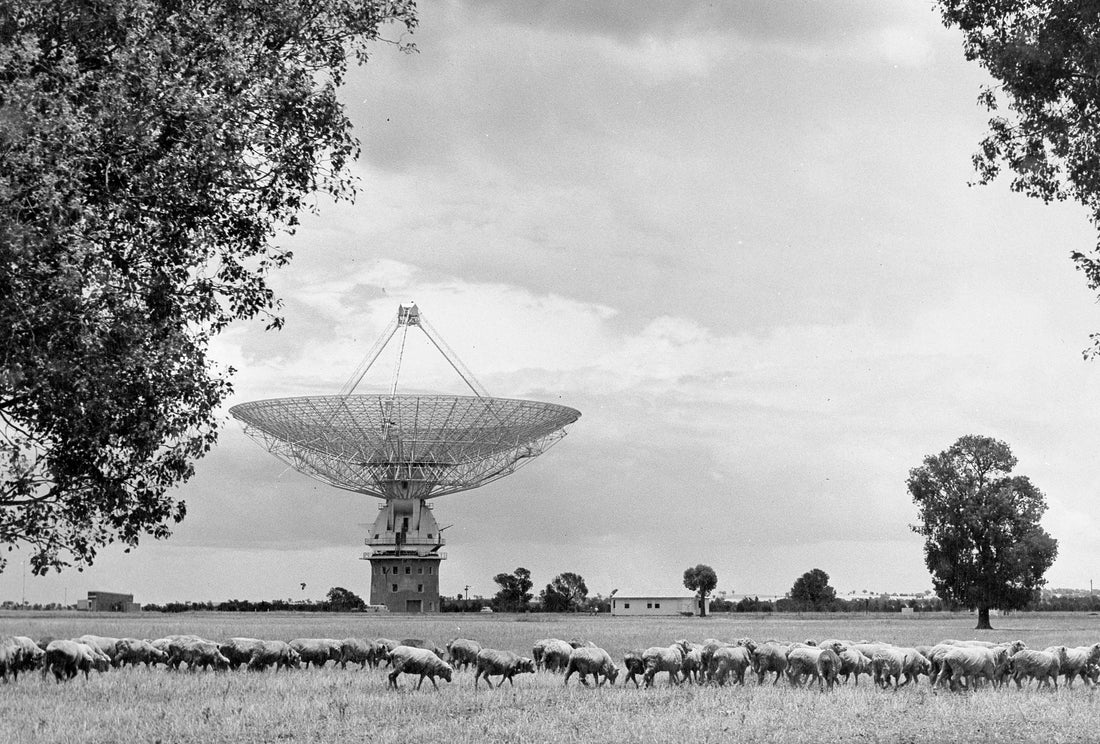
Stand Proud, "The Dish" Is Finally Added To Our National Heritage List.
Share
The Iconic Dish is finally getting the recognition it deserves after its considerable contribution to thrusting Aussie space into the deep unknown.
The Parkes Radio Telescope is officially added to the National Heritage List, joining the likes of Uluru, The Sydney Opera House, and The Great Barrier Reef. Australia's Minister for the Environment Sussan Ley announced yesterday that the CSIRO owned and operated scientific instrument was the first of its kind added to the list.
And at nearly 60 years old, the 64 metres in diametre telescope is still very much in use today as a relay station thanks to Australia's unique position on Earth. This location has made one of the largest single-dish telescopes in the southern hemisphere crucial in many of humanity's greatest triumphs in space.

Credit: CSIRO
In July 1969, The Dish worked along with Honeysuckle Creek Station (ampng other things...) to relay the Apollo 11 mission where the first human stepped foot on the moon and was broadcast to over 600 million people worldwide.
More recently, The Dish has found the majority of known pulsars, rapidly spinning neutron stars, as well as discovering the first 'fast radio burst', a mystery yet to be solved.
“The Dish is part of Australia's proud cultural and scientific history and to this day continues to serve as an important tool in our understanding of the Universe. As Australia again plays a critical role in the next efforts to put people on the Moon, and go on to Mars, this listing couldn’t come at a more appropriate time,” said Karen Andrews, Australian Minister for Industry, Science and Technology.
Within the CSIRO, the gravity of the listing is not lost on Chief Executive Dr Larry Marshall. "Australia has a long and proud history of science-driven innovation, from our first digital computer (CSIRAC) to the first air defence radar which helped to pave the way for the new field of radio astronomy after World War II, and more recently the development of fast Wi-Fi that connects people across the world to the internet,” Dr Marshall said.
“While the Parkes telescope may be old enough to qualify for the National Heritage List, it continues to operate as one of the world’s leading astronomy instruments, observing the Universe day and night, seven days a week, with the most advanced radio receiver systems in the world."
 Credit: CSIRO
Credit: CSIRO
Throughout its lifetime, The Dish has been continually upgraded to stay modern in a fast-moving industry such as space, with upgrades to become 10,000 times more sensitive than when it was first constructed in 1961.
Current users of The Dish speak fondly of it, not for its legacy, but for its ability to stay relevant and continually add to the bank of human knowledge about the universe.
“Parkes was the very first telescope I visited as a student and it has remained a constant companion throughout my career,” said Professor McClure-Griffiths.
“I have exploited its incredible sensitivity to reveal the Milky Way’s interstellar gas in all its glory. As far as telescopes go, Parkes was my first love – a love that has been kept alive through CSIRO's outstanding instrumentation on this grand icon of radio astronomy. Parkes is as much a marvel of engineering now as it ever was.”
The same sentiments are held by locals including Mayor of Parkes Shire Council, Councillor Ken Keith who said: "It holds a special place in all of our hearts,” Cr Keith said.
“The telescope has attracted an array of talented staff throughout its years, embedding a base of scientific and intellectual knowledge and culture within our region which has in turn further stimulated a scientific interest within the broader community and inspired our young citizens. The telescope has certainly cemented its position as an iconic attraction for not only our community, but has gained worldwide attention, and has been pivotal to the growth of the Parkes Shire visitor economy,”

Credit: CSIRO
Below are some of the more impressive feats the Parkes Radio Telescope is known for in its rich history:
- 1961: Construction of the 64-metre diameter telescope at CSIRO’s Parkes Observatory is completed, an achievement of engineering and technical design.
- 1962: Researchers using Parkes find that our Galaxy has a magnetic field a million times weaker than Earth’s magnetic field.
- 1968: Astronomers using Parkes detect pulsar signals, just weeks after UK researchers announce the discovery of pulsars.
- 1969: Parkes receives television signals from the Apollo 11 Moon landing and relays them to a worldwide audience of 600 million people.
- 1973: Parkes discovers the Magellanic Stream, a long trail of hydrogen gas flowing from two small neighbouring galaxies called the Large and Small Magellanic Clouds.
- 1982: Researchers using Parkes discover a quasar called PKS 2000-330, the most distant object in the Universe known at the time.
- 1998-2003: Astronomers carry out a survey with Parkes that reveals a new spiral arm in our Galaxy.
- 2003: Astronomers using Parkes discover the first known double pulsar system which enables stringent tests of Einstein's Theory of General Relativity.
- 2007: An unexpected burst of radio waves, more recently known as a ‘fast radio burst’, is found using Parkes archival data.
- 2011: Astronomers using Parkes discover a planet, most likely composed of compressed carbon, in orbit around a pulsar that is dubbed the ‘diamond planet’.
- 2018-19: NASA uses Parkes to support the Canberra Deep Space Communication Complex in tracking the Voyager 2 spacecraft as it enters interstellar space.
Have you seen the film?
What are your thoughts?
Please share with a friend who loves Aussie space history and spread ARSE to new horizons as we thrust into the deep unknown...
#Space_Aus




